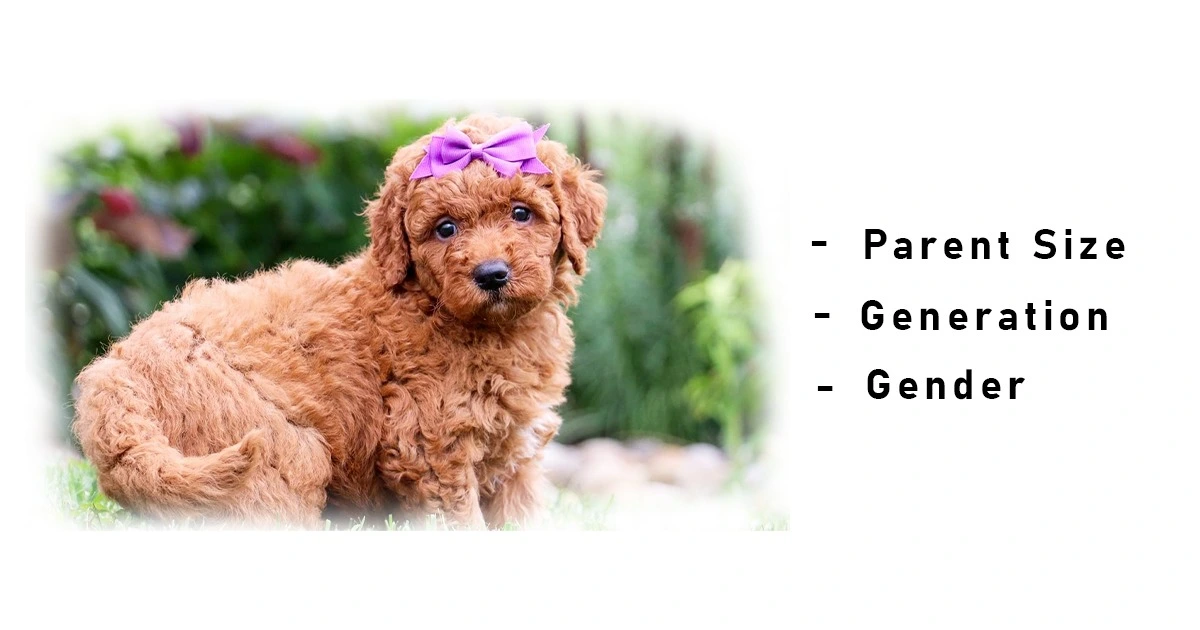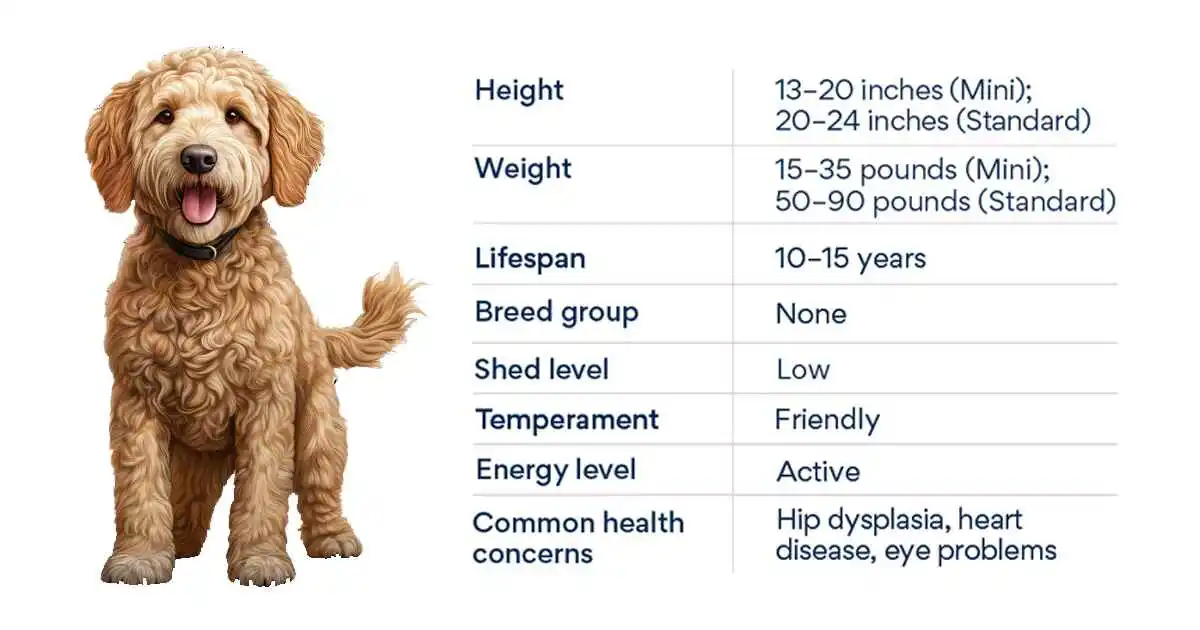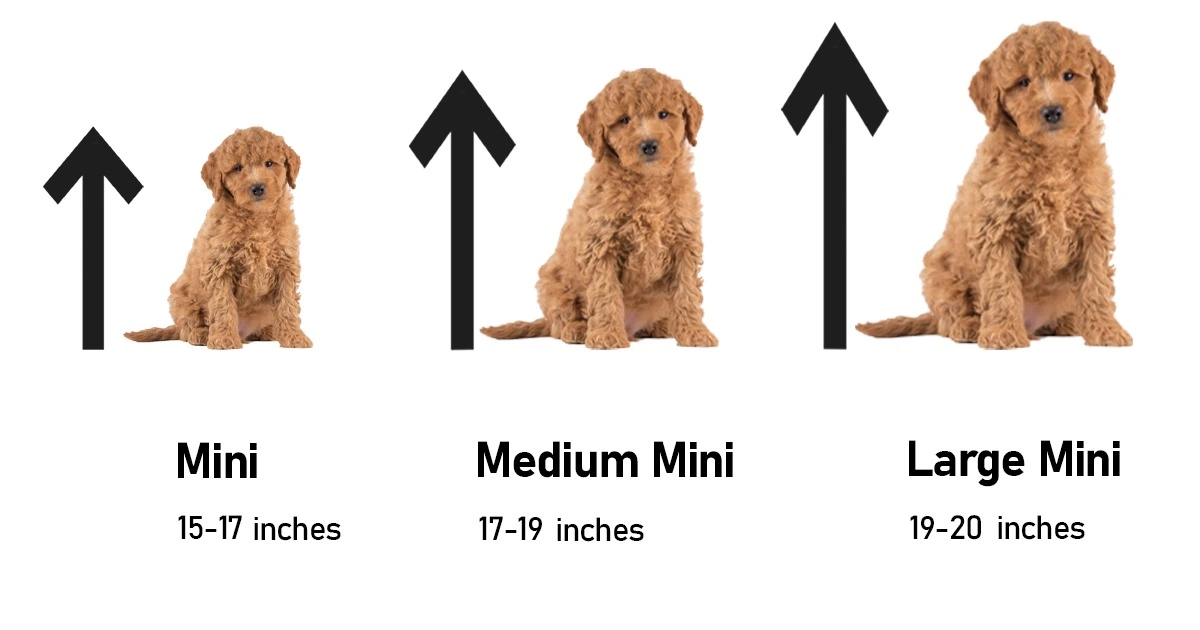Based on the information from the sources provided, Mini Goldendoodles can vary in size depending on factors like parent breeds, generation, and gender differences. Here is a summary of the key points regarding Mini Goldendoodle size:
Mini Goldendoodles are typically between 13 and 20 inches tall and can weigh between 10 to 35 pounds when fully grown. The size of each individual Mini Goldendoodle can vary depending on factors such as the parents and generation.
Table of Contents
ToggleMini Goldendoodles are known for their friendly and lovable temperament, making them excellent family pets that get along well with children and other animals. Factors influencing the size of a Mini Goldendoodle include parent breeds, gender differences, and the generation of the doodle, which can be F1, F1B, F2B, or multi-generation.
An F1b Mini Goldendoodle, which is 75% Mini Poodle and 25% Golden Retriever, is smaller than a typical Goldendoodle and closer in size to Miniature Poodles, weighing around 15-25 lbs when fully grown. In summary, Mini Goldendoodles are a popular choice for those seeking a smaller, friendly, and affectionate canine companion that fits well in various living spaces.
Understanding Mini Goldendoodle Size:
Mini Goldendoodles are a delightful hybrid breed, typically ranging in size from 13 to 20 inches in height at the shoulder and weighing between 15 to 35 pounds. The exact size of a Mini Goldendoodle can vary depending on the size of the Poodle parent, with smaller Poodles generally resulting in smaller offspring.
Despite their compact stature, Mini Goldendoodles maintain the robust build of their Golden Retriever lineage. Their size makes them ideal for various living situations, whether in apartments or larger homes with yards. Their manageable size also makes them a popular choice for families, singles, and seniors alike, as they are easier to handle and require less space compared to their larger Goldendoodle counterparts.

Mini Goldendoodle Size and Lifespan
Mini Goldendoodles are a smaller version of the Goldendoodle breed, with their size typically ranging between 15 to 35 pounds and a height of 13 to 20 inches at the shoulder. The lifespan of a Mini Goldendoodle generally spans from 12 to 15 years, influenced by genetics, diet, and overall health care. These dogs are a popular choice for those seeking a compact, yet energetic and affectionate companion.
Mini Goldendoodle Size Chart: Perfect fits for any Home
Here is a general size chart to help you understand the size range for mini Goldendoodles:
| Size Category | Weight Range (lbs) | Height Range (inches) |
| Toy Mini | 15 – 25 | 13 – 15 |
| Mini | 25 – 35 | 15 – 17 |
| Medium Mini | 35 – 45 | 17 – 19 |
| Large Mini | 45 – 55 | 19 – 20 |
Kindly note that these reaches are inexact and can fluctuate contingent upon different variables, as referenced prior. For more precise information regarding the mini Goldendoodle size, it is always best to consult a reputable breeder.
Factors That Affect the Size of a Mini Goldendoodle:
A few elements can impact the Mini Goldendoodle size.

Size Characteristics
The characteristics of Mini Goldendoodles make them suitable for various living environments, from apartments to houses with yards. Their manageable size, coupled with their friendly and affectionate nature, makes them ideal for families, singles, and seniors alike. Mini Goldendoodles are also known for their hypoallergenic coats, especially those with more Poodle genetics, making them a great option for people with allergies.
These variables include:
Parent Size:
The size of the parent dogs straightforwardly influences the size of their posterity. Raisers generally pair a Mini Poodle with a more modest Brilliant Retriever to deliver small Goldendoodles. Breeders can increase the likelihood of producing smaller puppies by selecting parents with smaller frames. However, there can still be some variation in size within a litter.
Generation:
Mini Goldendoodles can be isolated into various ages in view of their ancestry. F1B, F1BB Mini Goldendoodles, for instance, are the posterity of a Mini Goldendoodle and a Mini Poodle. These F1B young doggies will generally be more modest than F1 Mini Goldendoodles, which are the consequence of rearing a Mini Poodle with a Brilliant Retriever. The mini Goldendoodle size can be affected by how it is produced.
Gender:
A mini Goldendoodle’s size can also be affected by the breed and gender. Usually, Males are somewhat greater than females, yet the thing that matters is typically not much. Consider the potential difference in size when choosing between a male and female mini Goldendoodle, especially if you have specific size preferences.
Can we increase the size of the mini Goldendoodle
While you cannot naturally change the genetic size potential of a Mini Goldendoodle, there are a few ways to ensure they reach their full size potential and maintain good health:
- Proper Nutrition: Ensure your Mini Goldendoodle receives a balanced diet with high-quality food rich in essential nutrients. This supports healthy growth and development.
- Regular Exercise: Provide appropriate levels of exercise to strengthen muscles and support overall growth. Avoid excessive exercise in puppies to prevent joint issues.
- Routine Veterinary Care: Regular vet check-ups can help monitor your dog’s growth and catch any health issues early.
- Genetic Considerations: If size is a significant concern, consider the size of the parent dogs when selecting a Mini Goldendoodle puppy. Some breeders may offer slightly larger or smaller variations.
- Adequate Rest: Ensure your dog gets plenty of rest, especially during growth phases. Overexertion can negatively impact their development.
Remember, the term “Mini” in Mini Goldendoodle refers to a smaller size category within the breed, and individual growth can vary based on genetics and care.
Mini Goldendoodle Size Variations:
While Mini Goldendoodles for the most part fall inside a particular size range, there can be varieties. It’s possible that some people are slightly smaller or larger than the average person. Genetics, breeding, and other influences can all contribute to these variations.
It is essential to keep this in mind when considering a mini Goldendoodle and to inform the breeder of your preference for size so that they can select the best dog for you.

The most effective method to Pick the Right Mini Goldendoodle Size for You:
Picking the right little Goldendoodle size for yourself as well as your family depends upon a couple of factors.
Consider the following when making your decision:
Living Space:
If you live in an apartment or have a small space at home, a little mini Goldendoodle could be just perfect for you. They’re tiny, so they’re totally at home and cheerful even in cozier living spots.2.
Activity Level:
Consider your degree of action and how much activity you can give your dog. Mini Goldendoodles may require less exercise than larger breeds. Regardless, it’s basic to observe that all pups need standard action to stay sound and ecstatic.
Handling Ability:
Suppose how well you can deal with and control a dog of a specific size. If you have young children or elderly family members who may struggle with larger, more active dogs, Mini Goldendoodles are typically easier to handle.
Personal Preference:
At last, individual inclination assumes a huge part in picking the right Mini Goldendoodle size. A few people incline toward more modest dogies for their transportability and simplicity of care, while others might favor a somewhat bigger small Goldendoodle in light of multiple factors. Consider your own inclinations while going with your choice.
Variations and Size Charts
The size of Mini Goldendoodles can vary depending on their generational mix and parent breeds. An F1 Mini Goldendoodle is a first-generation cross between a Golden Retriever and a Miniature Poodle, while an F1B Mini Goldendoodle is backcrossed with a Poodle, often resulting in smaller sizes. F1BB Mini Goldendoodles, which are backcrossed again, tend to be even more petite. Size charts for Mini Goldendoodles can help predict their growth stages:
- 8 weeks: 4-9 pounds
- 16 weeks: 8-18 pounds
- 6 months: 10-25 pounds
- 12 months: 15-35 pounds (full grown)
Types and Comparisons
Mini Goldendoodles come in several size variations, including:
- Miniature Goldendoodle: 15 to 35 pounds, 13 to 20 inches tall
- Petite Goldendoodle: Often smaller than the standard mini, typically under 15 pounds
- Small Goldendoodle: Another term often used interchangeably with Mini Goldendoodle Comparatively, Medium Goldendoodles weigh between 35 to 50 pounds, and Standard Goldendoodles can range from 50 to 90 pounds, showcasing the compact nature of the Mini variety.
Mini Goldendoodle Size Care and Maintenance:
Mini Goldendoodles typically weigh between 20-40 pounds and stand 16-20 inches tall. They are known for their friendly and lovable temperament, making them excellent family pets that get along well with children and other animals
Here are some consideration and support tips to remember:
Grooming:
Miniature Goldendoodles have a wavy or wavy coat that requires customary brushing to forestall matting and tangling. To keep their coat in good condition, they also require professional grooming on occasion.
Training:
Like all pups, small Goldendoodles benefit from submission preparing and socialization. Early Mini Goldendoodle training assists them with growing great habits and guarantees they become respectful relatives.

Nutrition:
Maintain a consistent, nutritious feeding routine for your little Goldendoodle that takes note of their size and amount of activity. See your veterinarian to find out what kind and amount of food your dog requires.
Clinical consideration:
Standard veterinary check-ups, vaccinations, and preventive thought are crucial for keep your Mini Goldendoodle solid. Dental consideration, insect and tick counteraction, and immunizations ought to be generally current.
Size and Needs for Exercise for Mini Goldendoodles:
Mini Goldendoodles, in comparison with bigger and more dynamic varieties, have moderate activity necessities. Day to day strolls, play meetings, and mental excitement are valuable for their prosperity.

Associating with them in works out, for instance, quiet submission getting ready, puzzle toys, and coordinated playdates can keep them mentally and really energized.
- Daily walks and playtime are essential for Small Goldendoodles.
- Mental excitement through exercises like dutifulness preparing and puzzle toys is helpful.
- Directed playdates with different canines can give socialization and exercise potential open doors.
- While Little Goldendoodles have moderate action needs, outfitting them with ordinary physical and mental feeling is huge.
Nevertheless, it’s essential to avoid overexertion, as their more unassuming size makes them leaned to overheating.
Growth and Health Monitoring
Monitoring the growth and health of Mini Goldendoodles is crucial for ensuring a healthy life. Weight charts by age can help owners track their dog’s development, ensuring they are within a healthy range. Regular vet check-ups, a balanced diet, and sufficient exercise contribute to their overall well-being. Mini Goldendoodles are generally healthy, but they can be prone to conditions such as hip dysplasia and eye problems, so proactive health care is important.
Key Points:
- Mini Goldendoodles typically weigh 15-35 pounds and stand 13-20 inches tall.
- They have a lifespan of 12-15 years.
- Various size categories include Miniature, Petite, and Small Goldendoodles.
- Size charts help track their growth stages.
- Their friendly nature and hypoallergenic coats make them ideal companions.
Conclusion:
It is major for consider the dog’s size and the way that it will get into your lifestyle while picking a Mini Goldendoodle. These adorable mixed breed canines join the information and fellowship of Splendid Retrievers with the more humble level of miniature Poodles, making them an ideal partner for certain families.
You can find the ideal Small Goldendoodle for yourself as well as your family by finding out about their different sizes and considering things like living space, action level, and individual inclinations.
- Mini Goldendoodles are incredible family pets since they consolidate insight and friendship impeccably.
- Factors, for instance, living space and development level should be contemplated while picking a Small Goldendoodle.
- Correspondence with respectable reproducers and legitimate consideration are fundamental for guaranteeing the prosperity of your Miniature Goldendoodle.
To guarantee a long and productive organization, it is fundamental to speak with respectable raisers and put a high need on the upkeep and care of your Small Goldendoodle.
FAQs
Little Goldendoodles normally stand between 13 to 20 inches tall at the shoulder and weigh some place in the scope of 15 to 35 pounds.
While it’s not definite, you can figure in light of the size of the guardians and the common size range for Little Goldendoodles.
Typically, Miniature Goldendoodles arrive at their regular between 12 to 18 months, however, some might keep on finishing up until they’re 2 years of age.
Genetics are the main influencer, especially the size of the parent dogs, particularly the Poodle parent. Good nutrition and health in puppyhood also play a role.
Yes, there can be. Some may be smaller, while others may be larger, but they should generally fit within the established size range.
Yes, they can. For example, F1B Mini Goldendoodles, bred back to a Poodle, tend to be smaller due to more Poodle genetics.
A healthy diet and regular exercise will help maintain your Mini Goldendoodle’s genetically developed size, but they won’t significantly change it.
Every dog is unique. As long as your pup is healthy and happy, size differences typically aren’t a big concern.
Both very little and very large dogs may be more sensitive to certain health issues, such as joint issues in larger dogs or hypoglycemia in very small dogs. Frequent veterinary checkups are essential.
No, size is just one aspect. Consider temperament, energy level, grooming needs, and how they fit into your lifestyle as well.



